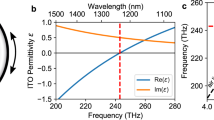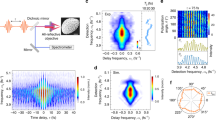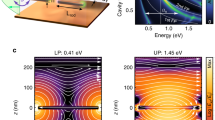Abstract
In atomic physics, the coherent coupling of a broad and a narrow resonance leads to quantum interference and provides the general recipe for electromagnetically induced transparency (EIT). A sharp resonance of nearly perfect transmission can arise within a broad absorption profile. These features show remarkable potential for slow light, novel sensors and low-loss metamaterials. In nanophotonics, plasmonic structures enable large field strengths within small mode volumes. Therefore, combining EIT with nanoplasmonics would pave the way towards ultracompact sensors with extremely high sensitivity. Here, we experimentally demonstrate a nanoplasmonic analogue of EIT using a stacked optical metamaterial. A dipole antenna with a large radiatively broadened linewidth is coupled to an underlying quadrupole antenna, of which the narrow linewidth is solely limited by the fundamental non-radiative Drude damping. In accordance with EIT theory, we achieve a very narrow transparency window with high modulation depth owing to nearly complete suppression of radiative losses.
This is a preview of subscription content, access via your institution
Access options
Subscribe to this journal
Receive 12 print issues and online access
$259.00 per year
only $21.58 per issue
Buy this article
- Purchase on Springer Link
- Instant access to full article PDF
Prices may be subject to local taxes which are calculated during checkout




Similar content being viewed by others
References
Boller, K. J., Imamoglu, A. & Harris, S. E. Observation of electromagnetically induced transparency. Phys. Rev. Lett. 66, 2593–2596 (1991).
Harris, S. E. Electromagnetically induced transparency. Phys. Today 50, 36–42 (1997).
Fleischhauer, M., Imamoglu, A. & Marangos, J. P. Electromagnetically induced transparency: Optics in coherent media. Rev. Mod. Phys. 77, 633–673 (2005).
Hau, L. V., Harris, S. E., Dutton, Z. & Behroozi, C. H. Light speed reduction to 17 m s−1 in an ultracold atomic gas. Nature 397, 594–598 (1999).
Shvets, G. & Wurtele, J. S. Transparency of magnetized plasma at the cyclotron frequency. Phys. Rev. Lett. 89, 115003 (2002).
Liu, C., Dutton, Z., Behroozi, C. H. & Hau, L. V. Observation of coherent optical information storage in an atomic medium using halted light pulses. Nature 409, 490–493 (2001).
Lukin, M. D. & Imamoglu, A. Controlling photons using electromagnetically induced transparency. Nature 413, 273–276 (2001).
Xu, Q. F. et al. Experimental realization of an on-chip all-optical analogue to electromagnetically induced transparency. Phys. Rev. Lett. 96, 123901 (2006).
Alzar, C. L. G., Martinez, M. A. G. & Nussenzveig, P. Classical analog of electromagnetically induced transparency. Am. J. Phys. 70, 37–41 (2002).
Waks, E. & Vuckovic, J. Dipole induced transparency in drop-filter cavity-waveguide systems. Phys. Rev. Lett. 96, 153601 (2006).
Yanik, M. F., Suh, W., Wang, Z. & Fan, S. H. Stopping light in a waveguide with an all-optical analog of electromagnetically induced transparency. Phys. Rev. Lett. 93, 233903 (2004).
Papasimakis, N., Fedotov, V. A. & Zheludev, N. I. Metamaterial analog of electromagnetically induced transparency. Phys. Rev. Lett. 101, 253903 (2008).
Zhang, S., Genov, D. A., Wang, Y., Liu, M. & Zhang, X. Plasmon-induced transparency in metamaterials. Phys. Rev. Lett. 101, 047401 (2008).
Verellen, N. et al. Fano resonances in individual coherent plasmonic nanocavities. Nano Lett 9, 1663–1667 (2009).
Hao, F. et al. Symmetry breaking in plasmonic nanocavities: Subradiant LSPR sensing and a tunable Fano resonance. Nano Lett. 8, 3983–3988 (2008).
Lal, S., Link, S. & Halas, N. J. Nano-optics from sensing to waveguiding. Nature Photon. 1, 641–648 (2007).
Liu, N. et al. Three-dimensional photonic metamaterials at optical frequencies. Nature Mater. 7, 31–37 (2008).
Tikhodeev, S. G., Yablonskii, A. L., Muljarov, E. A., Gippius, N. A. & Ishihara, T. Quasiguided modes and optical properties of photonic crystal slabs. Phys. Rev. B 66, 045102 (2002).
Johnson, P. B. & Christy, R. W. Optical constants of the noble metals. Phys. Rev. B 6, 4370–4379 (1972).
Ordal, M. A. et al. Optical properties of the metals Al, Co, Cu, Au, Fe, Pb, Ni, Pd, Pt, Ag, Ti, and W in the infrared and far infrared. Appl. Opt. 22, 1099–1119 (1983).
Zhang, S. et al. Demonstration of metal-dielectric negative-index metamaterials with improved performance at optical frequencies. J. Opt. Soc. Am. B 23, 434–438 (2006).
Dolling, G., Enkrich, C., Wegener, M., Soukoulis, C. M. & Linden, S. Simultaneous negative phase index and group velocity of light in a metamaterial. Science 312, 892–894 (2006).
Prodan, E., Radloff, C., Halas, N. J. & Nordlander, P. A hybridization model for the plasmon response of complex nanostructures. Science 302, 419–422 (2003).
Ropers, C. et al. Femtosecond light transmission and subradiant damping in plasmonic crystals. Phys. Rev. Lett. 94, 113901 (2005).
Tassin, P., Zhang, L., Koschny, T., Economou, E. N. & Soukoulis, C. M. Low-loss metamaterials based on classical electromagnetically induced transparency. Phys. Rev. Lett. 102, 053901 (2009).
Tassin, P., Zhang, L., Koschny, T., Economou, E. N. & Soukoulis, C. M. Planar designs for electromagnetically induced transparency in metamaterials. Opt. Express 17, 5595–5605 (2009).
Liu, N., Liu, H., Zhu, S. N. & Giessen, H. Stereometamaterials. Nature Photon. 3, 157–162 (2009).
Acknowledgements
We would like to thank M. Dressel and C. Soennichsen for useful discussions and comments. We acknowledge S. Hein for his metamaterial visualizations. We acknowledge S. Kaiser, H. Graebeldinger and M. Ubl for technical assistance. This work was financially supported by Deutsche Forschungsgemeinschaft (SPP1391 and FOR557), by Landesstiftung BW and by BMBF (13N9155 and 13N10146).
Author information
Authors and Affiliations
Contributions
All authors contributed extensively to the work presented in this paper.
Corresponding author
Supplementary information
Supplementary Information
Supplementary Information (PDF 204 kb)
Rights and permissions
About this article
Cite this article
Liu, N., Langguth, L., Weiss, T. et al. Plasmonic analogue of electromagnetically induced transparency at the Drude damping limit. Nature Mater 8, 758–762 (2009). https://doi.org/10.1038/nmat2495
Received:
Accepted:
Published:
Issue Date:
DOI: https://doi.org/10.1038/nmat2495
This article is cited by
-
Synthesized complex-frequency excitation for ultrasensitive molecular sensing
eLight (2024)
-
Magneto-optical heterostructures with second resonance of transverse magneto-optical Kerr effect
Scientific Reports (2024)
-
High Q Factor and Sensitivity Fano Resonance Based on a Graphene-With Ring-Column Dimer Array Structure
Plasmonics (2024)
-
Manipulating light transmission and absorption via an achromatic reflectionless metasurface
PhotoniX (2023)
-
Reflective ultra-wideband dual-band linear-to-circular polarization converter based on metasurface
Optical Review (2023)



